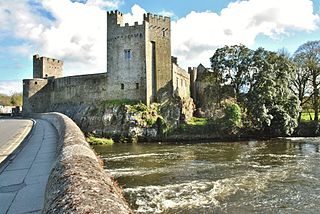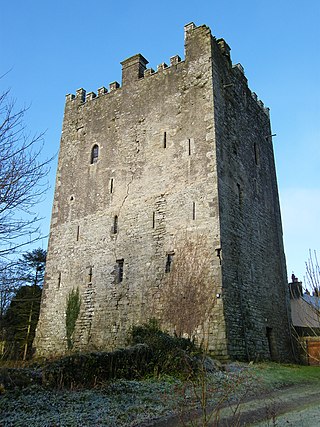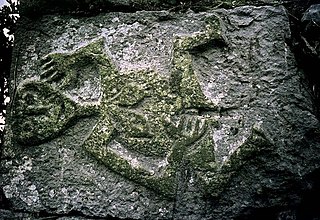Related Research Articles

Baron Dunboyne was a title first held by the Petit family some time after the Norman invasion of Ireland.

Sheela na gigs are figurative carvings of naked women displaying an exaggerated vulva. They are architectural grotesques found throughout most of Europe on cathedrals, castles, and other buildings.

Cahir Castle, one of the largest castles in Ireland, is sited on an island in the river Suir. It was built from 1142 by Conchobar Ua Briain, King of Thomond. Now situated in Cahir town centre, County Tipperary, the castle is well preserved and has guided tour and audiovisual shows in multiple languages.

Roscrea is a market town in County Tipperary, Ireland, which in 2016 had a population of 5,446. Roscrea is one of the oldest towns in Ireland, having developed around the 7th century monastery of Saint Crónán of Roscrea, parts of which remain preserved today.

Fethard is a small town in County Tipperary, Ireland. Dating to the Norman invasion of Ireland, the town's walls were first laid-out in the 13th century, with some sections of these defensive fortifications surviving today.

Knappogue Castle is a tower house, built in 1467 and expanded in the mid-19th century, located in the parish of Quin, County Clare, Ireland. It has been restored and is open to guided tours.

Ballaghmore is a small village located on the western side of County Laois, Ireland, southwest of Portlaoise. It is approximately 7 kilometres (4 mi) east of Roscrea. The village is in the civil parish of Kyle in the historic barony of Clandonagh.

Redwood Castle is a Norman castle near Lorrha in County Tipperary, Ireland.
The Ballyfinboy River rises close to Moneygall in County Offaly, Ireland and flows in a generally northwesterly direction into Lough Derg at Drominagh. It forms part of the boundary between County Tipperary and County Offaly. The river flows through the towns of Cloughjordan and Borrisokane west of which it flows past Ballyfinboy Castle, a ruined tower house with a Sheela na gig in the townland of Ballyfinboy.
Joan Mary de Sales La Terriere (1889–1968) was an Irish socialite and equestrienne, born in County Tipperary. She was one of the early luminaries of show jumping. She was also the last plaintiff from Ireland to secure a parliamentary divorce via a bill in Westminster.
Edmond Butler, 3rd/13th Baron Dunboyne (1595–1640) was an Anglo-Irish nobleman of the early seventeenth century. His short life was full of violence and disputes over the Dunboyne inheritance. His father was murdered when Edmond was a small child, and Edmond as an adult was forced to defend a lengthy lawsuit brought by his uncle, who sought to disinherit him. In 1627 he killed his cousin James Prendergast in a quarrel over a disputed inheritance. For this crime, he was tried by his peers for manslaughter, but was acquitted.
Redwood is a townland in the historical Barony of Ormond Lower, County Tipperary, Ireland. It is also an electoral district in the Dáil constituency of Offaly having previously been part of the Tipperary North Dáil constituency.

Roscommon County Museum is a museum dedicated to the history of County Roscommon, and is run by the County Roscommon Historical and Archaeological Society. The museum is housed in a former Presbyterian church in Roscommon town.

Roscrea Castle is a 13th-century motte-and-bailey castle in the town of Roscrea, Ireland. The Castle consists of a walled courtyard, gate block, and angled towers. Along with 18th century Damer House and gardens, the Castle forms part of Roscrea Heritage Centre.

Clomantagh Castle is a 15th-century tower house located near Freshford, County Kilkenny, in Ireland. Originally constructed in the 1430s, additional buildings and outbuildings were added in the subsequent centuries - including a connected 19th century farmhouse. Carvings on the castle's walls include a Sheela na gig relief.

Castlemagner is a village and townland in the Duhallow area of north-west County Cork, Ireland. Castlemagner is within the Cork North-West.

The Coolaghmore sheela na gig was discovered in 1975 at the 13th century church at Coolaghmore, County Kilkenny, Ireland during clearance work at the graveyard. It is thought to have been buried in the 19th century. According to local sources, it had been found in a well in Kyle previously and been brought to Coolaghmore Graveyard. It was then donated to Rothe House Museum via Kilkenny Archaeological Society where it is on display in a bricked up window in the shop of the first of the three houses since about 2012. The sites and monuments records number is KK019-026170.

The Liathmore Sheela-na-gig is part of the northern doorway at the larger church ruin at Liathmore monastic site in the townland of Leigh, County Tipperary. Its Sites and Monuments Record no. is TN042-055004.

The Kiltinan Church sheela-na-gig is a carved depiction of a nude woman exposing her vulva which used to be part of Kiltinan Church ruin near Fethard, County Tipperary as a quoin stone in the Southwestern corner of the church. However, it was stolen in 1990 and has not been located since. Fethard Historical Society issued a Wanted poster to help with the retrieval. The National Sites and Monuments no. is TS070-101003.

Fethard Town Hall is a municipal building on Main Street in Fethard, County Tipperary, Ireland. It is currently used as a museum space and hosts the Fethard Horse Country Experience.
References
- ↑ Site Fact Sheet. Kiltinan Castle, National Inventory of Architectural Heritage, Ireland
- 1 2 Kiltinan Castle. Fethard.com. Retrieved on 2011-05-14.
- ↑ Kiltinan Castle, Tipperary South, National Inventory of Architectural Heritage, Ireland
- ↑ "Kiltinan, Tipperary South".
- ↑ "Kiltinan, Tipperary South".
- ↑ "Ireland's Sheela na Gigs: Kiltinan Castle". Archived from the original on 27 February 2010.
- ↑ ANNUAL NEWSLETTTER 2000. (PDF) . Retrieved on 2011-05-14.
- ↑ 1650: The Siege of Kilkenny Archived 2 March 2012 at the Wayback Machine . British-civil-wars.co.uk (2008-02-23). Retrieved on 2011-05-14.
- ↑ 1649-52: Cromwell's Conquest of Ireland Archived 2011-07-17 at the Wayback Machine , Tralee Times
- ↑ Kiltinan Castle, Tipperary South: Buildings of Ireland: National Inventory of Architectural Heritage. Buildingsofireland.ie. Retrieved on 2011-05-14.
- ↑ Life Piles of the Rich & Famous, Irish Independent
- ↑ Kiltinan Farms Archived 2010-12-14 at the Wayback Machine . Breederscup.com. Retrieved on 2011-05-14.
- ↑ Bannerman, Lucy (1 December 2016). "Lloyd Webber rides to the rescue" . Retrieved 18 October 2021.
